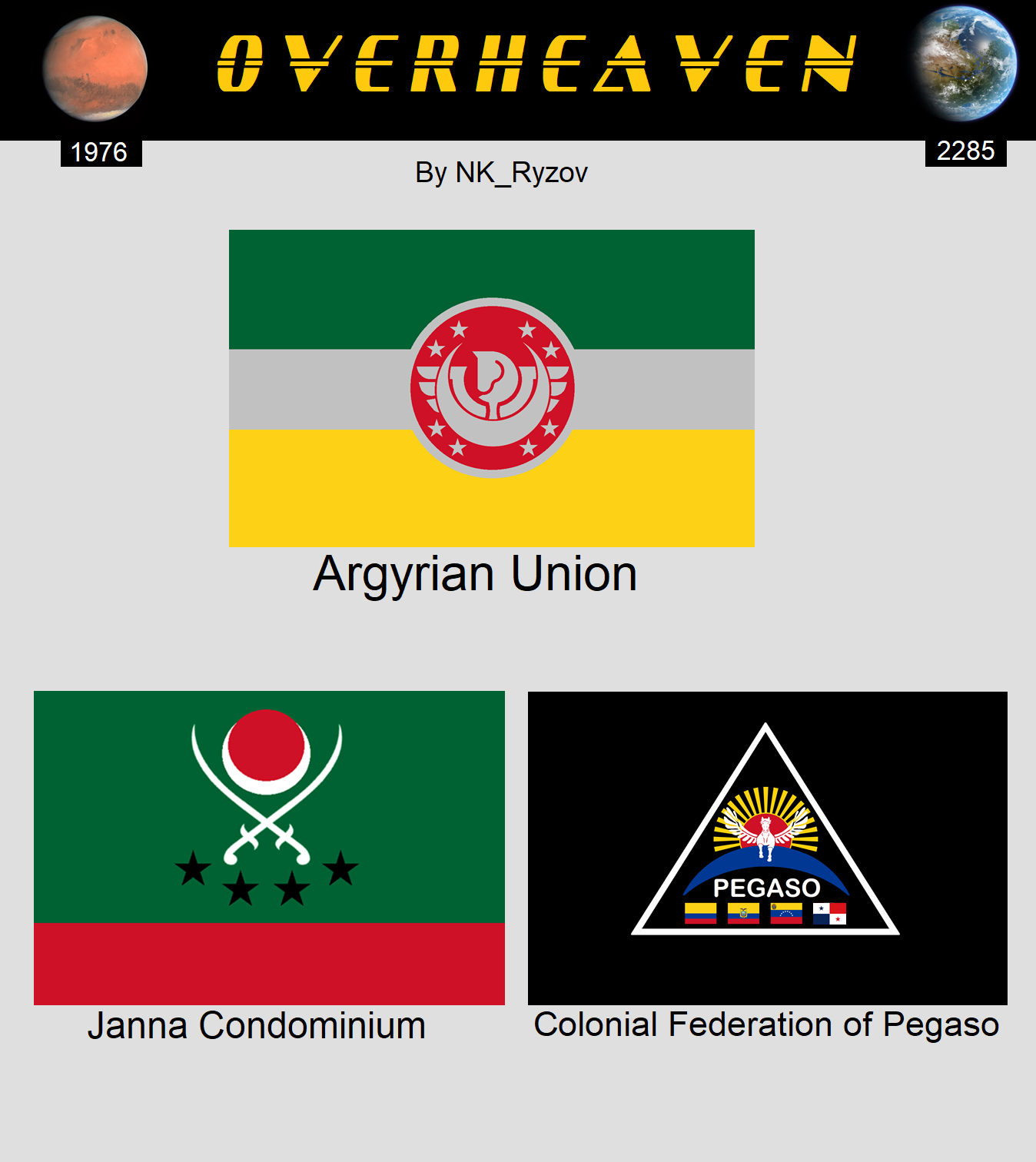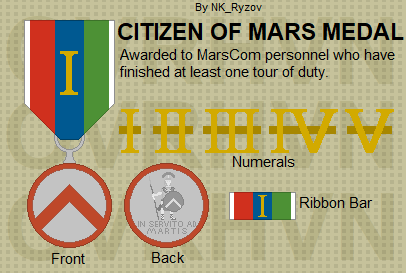HOME | DD
 NK-Ryzov — Flags of Argyre
NK-Ryzov — Flags of Argyre

Published: 2020-02-13 05:48:04 +0000 UTC; Views: 7151; Favourites: 53; Downloads: 17
Redirect to original
Description
========DA LORE
========
Argyre Planitia was discovered by Giovanni Schiaparelli in 1877, and is named after Argyre, the island of silver in Greek mythology. It is an impact basin centered at 49.7°S 316.0°E and lies between 35° and 61° S and 27° and 62° W in the Argyre quadrangle. It’s 1,800 km (1,100 mi) wide and drops 5.2 km (17,000 ft) below the surrounding plains; making it the second-deepest impact basin on Mars after Hellas Planitia.
Argyre was likely formed by a giant impact during the Late Heavy Bombardment of the early Solar System, 3.9 billion years ago, and at the time of colonization, might have been the best-preserved of the ancient impact basins from this period. The basin is surrounded by rugged massifs which form concentric and radial patterns around the basin, and several mountain ranges are present as well, including Charitum and Nereidum Montes.
During the Mars Treaty of 1979 saw Argyre divided up between eight nations. Saudi Arabia, Colombia, Qatar, Venezuela, the United Arab Emirates, Ecuador, Kuwait and Panama. The South Americans consolidated their efforts into the “Colonial Federation of Pegaso” (Federación Colonial de Pegaso), while the Gulf Arab states combined their colonial endeavors into the “Janna Condominium” (جانا عمارات). The relevance of the South American states to the colonization of Mars lay in their relationship with the United States; Panama, Ecuador and Colombia all leased land to the US for use as launch sites and gave preferable status to American mining concerns, in exchange for economic and military aid. And colonies on Mars. The Gulf Arabs didn’t really have a glut of good launch sites to offer the US, but who needs such things when you have oil? However, none of these countries had interplanetary transport capabilities, and would have to rely on American interplanetary vehicles to reach the stars, though by the start of the 2000’s, Saudi Arabia developed their own fleet of Mars Express IPV’s.
Pegaso was initially comprised of the settlements of Bolivar (international, capital of Pegaso), Arismendia (Venezuela), San Agustin (Colombia), Maldonado (Ecuador) and Mesa (Panama), while Janna was initially comprised of Janna Base (international, capital of Janna), Casbah (Saudi Arabia), Qadar (UAE), Khaled (Kuwait) and Tawhid (Qatar). In the 1980’s, growth was slow in the 1980’s, marred by repeated accidents, shortages and misfortunes, spurring a tradition of close, life-saving cooperation between the two peoples. In 2008, the Argyre Community was established, linking the economies of the two Martian countries together, eventually culminating in the establishment of the Argyrian Union in 2025.
The Argyrian Union or “Argyria'' represented the merger of these two peoples, and was the culmination of the marriage of Latin American and Gulf Arab culture, customs and ways of thinking. Some Pegasoans converted to Islam, while some Jannians converted to Catholicism. The latter was a much bigger deal than the former, considering three of the four Arab states which founded the Condominium treat apostasy as a crime. But on Mars, you gain an appreciation for very different things than you do on Earth, and for the people of the Argyre Basin, their differences are immaterial when they both have the Martian environment as a common opponent. Plus, most of the Gulf Arabs who settled the Red Planet were of the wealthy, “cafeteria Muslim” variety anyway; certainly a fair number of more conservative religious folks as well, but the same could be said for the Pegasoan Catholics. Linguistically, beginning in the 90’s, Pegasoans started teaching their kids Arabic as a second language and Jannians taught their kids Spanish. By the late 2010’s, an “Esparabic” creole had become a working language throughout the territory, and by the mid-2020’s, children were being raised with Esparabic as their first language.
Though all settlements were separated by the freeze-dried airless wasteland between them, radio communications and the frequency of trade via trucks and trains made this cultural cross-pollination possible. Not everyone was terribly thrilled about it. Conservative elements would occasionally set out from the major settlements to found culturally-homogenous towns in the hinterlands, which only served to further the colonization of Argyria. Indeed, the willingness of the Gulf Arabs on Mars to adopt aspects of Latin culture and even commit apostasy eventually led to the scaling back of relations between Janna and it’s four founding nations in the late 2010’s, which only encouraged the Jannians to rely more on their neighbors. Back in the major settlements, however, Middle Eastern and Latin American cuisine, fashions, culture, religion and bloodlines continued to mix and match throughout the 2010’s and 2020’s, as the Argyre Community (and then the subsequent Argyrian Union) embarked on joint transportation projects which made travel across the region that much easier, tightening the bonds between Janna and Pegaso, which made their eventual political union possible.
Also in the 2020’s, Argyre became enthralled with anti-terraforming sentiment, aligning itself more and more with “Red” polities such as Euromars, Magellan (the Chilean Mars colony), Qarmazi (Pakistani) and others in the Mercator Pact. In the aftermath of the Great Impact of 2014, the sublimation cycle liberated a fair amount of CO2 from the Argyrian soil, and in time, the lowest-lying regions of the basin began to fill with hypersaline water. If the “Blues” got their way, the Argyre national-populists proclaimed, the entire country would be underwater, if not from the water-ice contained with the soil of the region, then flooding down Nirgal Vallis in the north, as the northern polar lowlands turn into a vast ocean that surges southwards. Additionally, a substantial preservationist element lobbied against terraforming on the grounds that it would endanger the remnant microbial biospheres in the basin, which traced their ancestry back millions of years, when Argyre was still a lake.
Regarding terraforming efforts by the “TAK Axis” (Tharsis-Avalon-Kasei) as “genocidal” towards those at risk of the negative externalities of terraforming, the Argyrian Union began to arm itself from the mid-2020’s to the early-2030’s. At the outbreak of the EuroTAK War (2034-2037), Argyrian forces armed with 3D-printed AK-47’s and hastily-improvised armored fighting vehicles, successfully invaded under-militarized Petra (the Jordanian colony on Mars) and Huitzilin (Mexican), with assistance from Euromartian troops. Argyrians then assisted the Euromartian invasion of New California, with backup from Noachia (Brazilian), who broke their policy of neutrality in the belief that they should join the “winning side”. However, this was a bit premature. Despite gaining the initiative early on, Tharsian, Avalonian and Kaseijin military forces defeated Euromars and its allies. Argyria was occupied by Tharsis, and while there was discussion of partitioning the Union as was done with Euromars, this was dismissed.
As part of the TAK Alliance’s efforts to win over the defeated Mercator Pact and prepare them for the changes that terraforming would bring, considerable resources were invested in relocating Argyrians further inland. By the 2060’s, despite the massive Zubrin Dam reducing the flow of water into Valles Marineris, Nirgal Vallis became the mighty Nirgal River, and much of Argyre Planitia was flooded. However, by this point, most Argyrians had already relocated to the Charitum and Nereidum uplands. Indeed, whole cities were moved out of the basin and re-established along the shores of the “Argyrian Sea”, which, post-terraforming, have come to resemble a somewhat hotter version of the Mediterranean back on Earth.
Today, in 2285, distinctions like “Jannian” and “Pegasoan” are virtually nonexistant. Everyone in the region speaks Esparabic (plus English and Japanese, like all other Martians), though Arabic and Latin can still be heard as liturgical. These days, Argyrians are still quite religious, with most identifying as both Catholic and Muslim - observing both Ramadan and Easter. This interaction has been termed the “Savior-Prophet Communion”, but the Argyrians themselves don’t think it’s a big enough deal to deserve a name. In terms of influence, Argyria is a minor player in Martian affairs; Kasei and Tharsis are still the two top dogs, the biggest trend-setters and the most relevant combined culture on Mars. But y'know what? They’re fine with that.
========
DA FLAG
========
So, the flag of Janna features the colors red, green, white and black - all of which are relevent to the flags of the Gulf states which founded the Condominium. The two swords are theoretically intended to represent the nobility and fortitude of the Jannian settlers, but in truth, it was an open secret that there were six Saudis on the Jannian flag-design committee. The red stripe represents Mars, the white crescent and red disk...also represents Mars, the five black stars represent Saudi Arabia, Kuwait, Qatar and the UAE, and the green represents Islam.
The flag of Pegaso was based on the logo of the Pegaso (“Pegasus”) Program. The blue crescent with the rising sun in the background represents Mars. Why is this on a *Martian* flag? Your guess is as good as mine. The flag has the colony’s name, in case you forgot what this was for, the flags of the four countries involved in the colony project, a white triangle, because reasons, and a black field for...space? Hey, not every flag can be perfect. That just wouldn’t be realistic.
The flag of the Argyrian Union combines the crescent motif of the Jannian flag, with the Pegasoan...pegasus...along with eight stars to represent the eight founding Terran nations, which came together on Mars (represented by the red disk). The green stripe represents Islam, Janna, life, faith and vitality, while the gold represents Catholicism, Pegaso, wealth, wisdom and good fortune. And lastly, the use of silver on the flag is meant to represent Argyre’s namesake - the mythical Greek island of silver.
Related content
Comments: 3

👍: 0 ⏩: 0

Ah yes, my hunger for Overheaven lore has been sated. Nice job.
I await more.
👍: 0 ⏩: 1

Thanks. I’ve been on a serious Mars kick lately. The definitive version of “Schiaparelli’s Hammer” is in the works right now. “Adrestia’s Hammer: Mars in 2020”, now with 5,000% more lore - everything from how Martian smartphones evolved from counterfeit Gameboys, Mormon Shintoism, how rubber, plastic and pizza are all made on Mars, Martian pop culture, the marvels of bamboo, the yakuza-cops of Port Dread on Deimos, the legal framework for human cloning, and more things you never knew you wanted to know about Mars in the year 2020.
Still mulling over how to do the accompanying map, unfortunately - you’ll notice that almost every Mars map on DA is post-terraforming. Oceans are useful for letting you discount geographical features on dry land like mountains and such, but I need to figure out a way to make a map that shows geographical and political boundaries. On MS Paint. And then I have to place all of the canon settlements.
Yikes. Didn’t really think of the scale of this project until I wrote it out just now. Imagine being my brain. Hmm. I’ll figure something out.
In the mean time, lots of smaller stuff is still in the works as well, including more 2285 stuff.
👍: 0 ⏩: 0

























